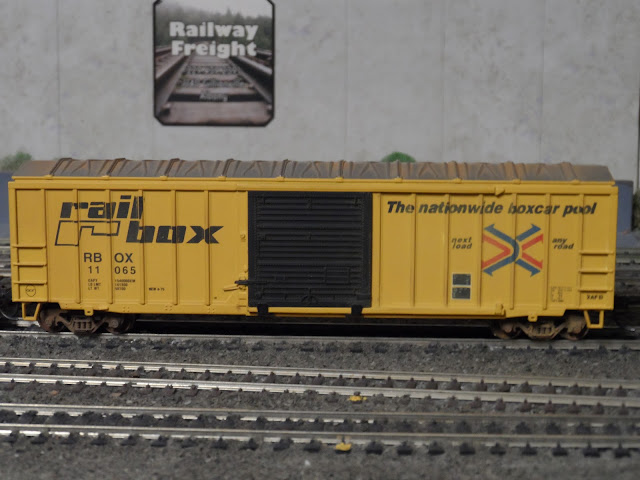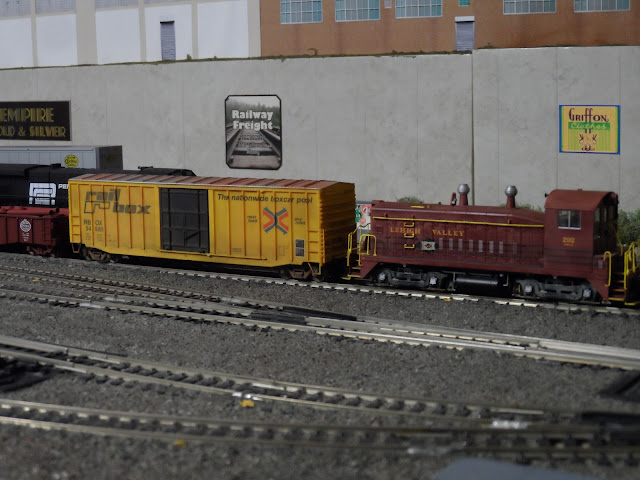Greetings All,
Empire Belt Railroad Operations Part 4
Welcome to another installment in this ongoing model railroad operations series. Today we'll take a look at Railbox boxcars and ways to add these "free runners" into the day to day operations on the layout.
Railbox
The Nationwide Boxcar Pool
"Next Load Any Road"
Railbox Company (reporting marks ABOX, FBOX, RBOX, TBOX), founded in 1974, is a North American boxcar pooling company, was a subsidiary of the Chicago based TTX Company. It was created by eleven solvent class one railroads that included the ATSF, BN, Chessie, MoPac, NW, RF&P, SLSF, SR, SP and UP to address a boxcar shortage in the United States in the 1970s. Railbox placed orders for 10,000 50-ft boxcars with the first car delivered on October 15, 1974.
"Boxcar, Railbox" by Gary Lee Todd, Ph.D. is marked with CC0 1.0. To view the terms, visit https://creativecommons.org/publicdomain/zero/1.0/?ref=openverse.
The concept behind Railbox, as evidenced by the slogan, "Next Load, Any Road" was, because Railbox was jointly owned as a privately owned cooperative. These boxcars were not subject to load/empty rules and could be assigned for service on any railroad in Canada, Mexico and the United States on lines where an AAR Plate-C loading gauge is permitted.
Railbox purchased boxcars from many manufacturers, including American Car and Foundry Company, FMC Corporation, and Pullman-Standard (P-S).
The Railbox cars were free runners like their parent company Trailer Train cars. They started to appear in 1974 with about 25,000 in service by 1981.
As new cars they earned a higher per diem of about $9.87 plus a mileage charge which was not to the level of IPD cars which earned a per diem of about $22.00 plus 4.7 cents per mile because they were not owned by a specific railroad and had no home rails.
Three Card Monty Anyone?
To maximize the operations potential of these free running next load any road boxcars I developed three movement slips for this sample Railbox boxcar.
Blue Waybill: Car comes on layout loaded from Astoria, Oregon originating on the SP&S loaded with plywood for Neal's Lumber & Hardware in Empire City.
Index Card: Car has been made empty on layout or off layout on LIRR rails and is to head back to the ATSF at Streator, IL. The cars have no specific owner but the ATSF is one of the group of owners so they are used to move the car off layout.
White Waybill: Standard waybill to control car movements.
White Waybill: Standard waybill to control car movements.
Putting The Waybills Into Play
Car Movement #1 RBOX 34685 has arrived in Terminal Yard with a load of plywood from Astoria Plywood in Astoria, Oregon that originated on the SP&S RR. The load is consigned to Neal's Lumber & Hardware in Empire City which is served by the Empire Belt RR.
Car Movement #2: RBOX 34685 is placed into train EC-1 for movement to Empire City and interchange with the Empire Belt RR.
Car Movement #4: The EBRR delivers the loaded car to Neal's Lumber & Hardware.
Car Movement #5: RBOX 34685 has been made empty and is pulled from Neal's Lumber & Hardware by the EBRR.
Car Movement #6: RBOX 34685 is delivered to North Side Yard. The Empire Belt RR freight agent is not in need of the RBOX 34685 so the car will be delivered to Terminal Yard.
Car Movement #7: RBOX 34685 has been delivered to Terminal Yard by the EBRR for movement off layout towards the ATSF. The Terminal Yard freight agent however puts a hold on it for local loading.
Car Movement #8: RBOX 34685 has been delivered to University Millwork and is now loaded with millwork for Direct Sash in Cambridge, Mass via the B&M.
Car Movement #9: RBOX 34685 is pulled from University Millwork and moved to Terminal Yard.
Car Movement #10: RBOX 34685 is placed in an outbound train for movement off layout to the B&M.
Car Movement #11: RBOX 34685 heads off layout towards Cambridge, Mass.
Other Options for RBOX 34685
The blue empty car request from University Millwork and the prepared waybills hold other movement options for RBOX 34685. Modelers using Railbox cars in model railroad operations have the options of using these cars for their next load to any road just like the Railbox slogan says.
Managing Railbox and I.P.D. Freight Cars
Freight agents, yard masters, clerks or whoever controls the empty freight car requests on your layout can have the added realism to send the correct freight cars to your online shippers that maximize your railroads profits. The decision on which cars go where to be loaded and which cars leave empty can make managing your freight yards a little more challenging and realistic.
Final Thoughts and Comments
Management of empties is a prototypical railroad operation. In the era I'm focusing on here the car service rules had many railroad owned empties moving in all directions towards their home rails. Foreign road cars earn per diem when on your rails. Railbox cars earn a higher per diem rate and the I.P.D. cars earn even more.
Railbox Lives On
Trackside observers know that Railbox cars still ply the rails in great numbers and this program that started in 1974 is still going strong fifty years later in 2024. Here is my most modern Railbox freight car. Unfortunately the 1:1 version has been vandalized with graffiti like so many other freight cars.
Additional information and links
Thanks for reading!!!
See you soon!!




















Another great and informative post about Railbox box cars! I do like the way you document all of your moves with this box car (and others since you’ve adopted using the car card system).
ReplyDeleteMost of the current 60’ box cars that I’ve seen that are owned by the current consortium have the Railbox ‘logo’; however, don’t have the word ‘Railbox’ word on them. It’s more of the reporting mark like ‘TBOX, ABOX’ and other lettering.
As far as adding this to operations, I’ve had the opportunity to use car cards on a friend’s layout. It does take some getting used to and of course takes more time for a session to be completed, especially when you have many operators.
Again, this was a great read and very enjoyable as well!
Thank you very much Sir Neal!!! Glad you enjoyed the post. Using car cards during operations can be cumbersome. Using a switch list based on the waybills is easier to handle. When the work is done just turn in the waybills with the freight cars to the yard master or whoever is responsible for keeping track of the car movements.
DeleteI really didn't know much about Railbox but always liked the look of those yellow freight cars. Thanks for the easy to follow description of the Railbox concept and the neatly modeled examples from the N.Y.C.T.L.! Your #34685 is nicely weathered by the way! Sorry to hear some fools defaced the pink prototype car honoring breast cancer patients. At least the 1:87th scale version on your layout is proudly pristine!
ReplyDeleteThank you very much Ralph. Digging into the workings of the AAR controlled RR owned, I.P.D. and Railbox freight cars provided some interesting tidbits that could be used for model railroad operations if one is so inclined. Glad you enjoyed the post!!!
Delete